
by Trish Adams | Sep 15, 2014 | Consistency, Fat Loss / Cutting, Motivation
Self-doubt happens to all of us at some point in our lives. On the journey to reaching a specific goal, negative thoughts make us question if we can achieve the very thing that we set out to accomplish. It’s these negative thoughts, when left untamed, which can affect our actions and lead to negative results.
Our patience can be particularly tested when it comes to reaching physique, strength, fitness or health-related goals where results are slow, or we feel we have less control over the outcome. Learning to catch negative thoughts as they happen is key to avoiding the slippery slope of negativity and ensuring you stay on the path you have set out on with a grateful, and optimistic outlook.
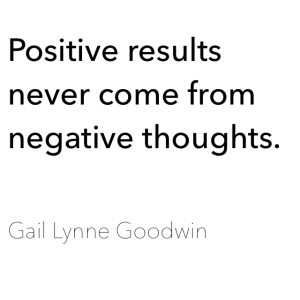 Let’s use this scenario as an example. You head to the gym on a Monday and have an awesome lift. You’re feeling good about yourself because you added 10 pounds to your bench and 20 pounds to your deadlift. In short, you feel like a BEAST!!! You wake up the next day, rush to the mirror and promptly start looking for changes, expecting to be rewarded for all your hard work (or…at very least, another glance at those gorgeous muscles you saw poppin yesterday). Instead you feel fluffy — not at all what you expected — and you’re holding water (100% normal following an incredible lift session!). Suddenly your attitude towards the day goes from “I’m ready for you!” to “Why should I even stay on track or hit the gym today?” Negative thoughts start to creep in and you’re convinced you have failed.
Let’s use this scenario as an example. You head to the gym on a Monday and have an awesome lift. You’re feeling good about yourself because you added 10 pounds to your bench and 20 pounds to your deadlift. In short, you feel like a BEAST!!! You wake up the next day, rush to the mirror and promptly start looking for changes, expecting to be rewarded for all your hard work (or…at very least, another glance at those gorgeous muscles you saw poppin yesterday). Instead you feel fluffy — not at all what you expected — and you’re holding water (100% normal following an incredible lift session!). Suddenly your attitude towards the day goes from “I’m ready for you!” to “Why should I even stay on track or hit the gym today?” Negative thoughts start to creep in and you’re convinced you have failed.
Wait. Wait, wait!
This is when you have to practice stopping those negative thoughts in their tracks. Try using the following tactics to keep your mind focused on the positive and stay headed in the right direction.
Remember how far you’ve come – On days where you’re struggling with the person in the mirror, or worse, the number on the scale, remember all that you have accomplished. Are you a reformed VLCD eater who now nourishes their body with the nutrients it needs? Are you a recovering binge-eater who no longer feels out of control when eating trigger foods? Have you overcome any physical challenges like being able to play with your kids without getting winded or, heck, maybe you can push a car! These are all victories that don’t reflect back to us when we are looking in the mirror or standing on the scale. Each and every one, no matter how big or small, should be acknowledged (often), celebrated, and used as fuel to push on.
Try something new – If you do the same routines week in and week out, it might be time for a change. Scratch that, i t most definitely is time for a change! Consider adding phases to your routine to be sure that you are getting the most out of your efforts. At a minimum, try a new exercise class, take your workout outside or invite a friend to the gym. Change it up. You will be amazed by your body’s ability to adapt to something new.
t most definitely is time for a change! Consider adding phases to your routine to be sure that you are getting the most out of your efforts. At a minimum, try a new exercise class, take your workout outside or invite a friend to the gym. Change it up. You will be amazed by your body’s ability to adapt to something new.
Be grateful for what you have – There are people who don’t have the health that allows them to get up every day and work out. Understand you are blessed to have this opportunity. View exercise as a way to thank your body for all it is capable of. Every day that you are able to push harder and get stronger is a gift.
Doubt can creep up at any time, not just during our weakest moments. Next time you feel a negative thought coming on, counter it with a positive one. Instead of thinking “my stomach looks puffy today,” try saying something like “I have strong, muscular legs.” Don’t let negative thoughts take you off the course you have set for yourself. Win these small battles one at a time. Your mind believes what you tell it, whether it is fact or fiction. Be sure you are feeding it positive thoughts.

by EM2WL | Sep 11, 2014 | Building Muscle, Consistency, Fat Loss / Cutting

If you’re newer to lifting, or perhaps just newer to lifting heavy – at some point you’ll wanna know just how long to see results from lifting.
Back in the day, it was easier to avoid the message that “lifting heavy changes your body, ” but lately it seems that most fit pros and enthusiasts have finally hopped on board. Whether you’ve decided to test the waters with Crossfit, finally hired a trainer, or simply do some workouts that you find on the internet: you’re lifting heavy, you’re loving it…and you’re not seeing these “miraculous” changes that everyone seems to be promoting. What.is.the.deal?
Here’s eight reasons why you may not be seeing results yet:
You still aren’t lifting heavy enough
I’m sure this is insulting to most people reading this. I mean, of course you’re lifting heavy enough. It’s a heavy weight, and you feel the burn when you lift it. Every body part requires a different weight. So if you’re using only one or two weight sizes, for your entire body – then it’s not possibly heavy enough for every area. A dumbbell of 10-12 pounds may be excruciatingly heavy for your smaller muscle groups like rear delts, but most ladies can lift much more than that for a back, chest, or leg movement. If you’re able to go beyond 12 reps on most exercises, it’s probably time to increase your weight.
Don’t think that you hard-core-iron-heads are exempt from this one. Sometimes, vets, we can be just as likely to get comfy with a certain weight. Are you’re cranking out 25lb dumbbell rows, just because it seems heavy enough for your 10-12 rep range? Or because it’s the highest weight available? Could you possibly go up to 30 or 35? Who cares if you can only make it to six to eight reps before you fail? Accept the challenge — if you can do it with good form — and work your way back up to 10 reps. If you can’t make such a huge jump, add some weighted gloves and increase by only two to four pounds at a time rather than the entire five. Either way, find your max for that number of reps, and then push past it. The only way to continue to see changes is to continually challenge yourself.
You’re basing your “results” judgement on a scale number
We’ll often hear from ladies who are lifting and aiming for fat loss say things like “I must be doing something wrong…I should have lost ‘X’ pounds/dress sizes by now”
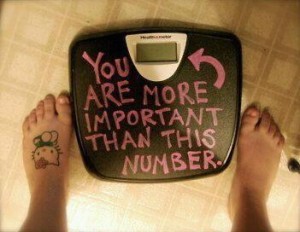 Ummm…Says who??? ;) How do we determine how many sizes we should be up or down within a year? I pray not by the same industry standards that tell us to “eat-less-than-you-need-to-support-your-body-in-a-comatose-state” for weight loss?
Ummm…Says who??? ;) How do we determine how many sizes we should be up or down within a year? I pray not by the same industry standards that tell us to “eat-less-than-you-need-to-support-your-body-in-a-comatose-state” for weight loss?
Sure…there will always be tweaks that you’ll want to make, but if your butt looks freakin amazing – take a moment to accept that, rather than be overly concerned about the number on the scale OR inside of your jeans.
Too many of us are still being held captive by our scale weight…or some other tracking method that doesn’t take into account the type of changes that are happening. Case in point: my pant size can vary from a size two to TEN in about 60 seconds (yet look just as lean in either size). How is this possible? My butt has seriously gotten so high that it ranges from one extreme to the other, based on the rise (and brand) of the jeans. If your body shape is changing, maybe it’s time to switch brand manufacturers. It sucks, but sometimes must be done. Trust me, you will see how great you look in clothes that fit. Every fashion book/expert on the market (that’s worth a darn) will tell you to stop giving two hoots about sizes. This is because no matter how small you are, sizes will vary — per person — in fit. FIT is everything.
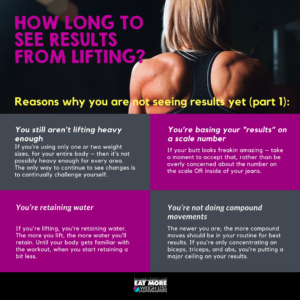 Confession time: The other day, I went out in frustration over all my older, lower rise jeans that weren’t fitting. Taking my own redundant advice — I bit the bullet and bought the exact same jeans in LARGER sizes to make sure they fit over my butt. Listen…the size was WAY larger…would you know I had FIVE people tell me I need to STOP losing weight when I was wearing those jeans?! I have gained over 10 lbs (apparently all in the bootay)!! But wearing jeans that FIT ME (note…did not say jeans that “I fit” into to) FIT, baby. Get clothes that fit, forget the rest. By the time you can squeeze into jeans from over a year ago, they’re probably outdated anyway :P
Confession time: The other day, I went out in frustration over all my older, lower rise jeans that weren’t fitting. Taking my own redundant advice — I bit the bullet and bought the exact same jeans in LARGER sizes to make sure they fit over my butt. Listen…the size was WAY larger…would you know I had FIVE people tell me I need to STOP losing weight when I was wearing those jeans?! I have gained over 10 lbs (apparently all in the bootay)!! But wearing jeans that FIT ME (note…did not say jeans that “I fit” into to) FIT, baby. Get clothes that fit, forget the rest. By the time you can squeeze into jeans from over a year ago, they’re probably outdated anyway :P
You’re retaining water
Yeah, yeah…we’re all tired of this excuse. But let’s face it. If you’re lifting, you’re retaining water. Sometimes LOTS of water. The more you lift, the more water you’ll retain. If you’re doing tons of HIIT, then consider it the cherry on top of your water-retention-sundae. Until your body gets familiar with the workout, when you start retaining a bit less. But then you change it again. And retain more water. It’s an ugly cycle. But not really. It is what it is. Ladies, we really have to get over this whole “water weight” thing. The more muscle mass you build, the more water you’ll begin to retain at all times. This really isn’t such a bad thing, but rather a sign that things are going well…as you’ll see here. But this does mean that you’ll have to give those scale dreams a rest, and focus on all the goodness and shifting that’s happening with your body. When it comes to lifting, things will occasionally appear to get worse before they get better. I just consider it the “labor pains” of muscle delivery — a tad “painful” when it’s happening, but most of us wouldn’t trade that muscle baby for the world once it arrives. ;)
Side note: If you’re totally convinced/upset/depressed that your pants are getting tighter, perhaps you need to cut down on low rep squatting for a while? Work your lower rep squatting in in phases, so that you still get the muscle building benefits, but aren’t constantly retaining water. But, if you adore your 5×5 deadlifts or what have you, just accept that you may be retaining some serious water…and invest in jeggings.
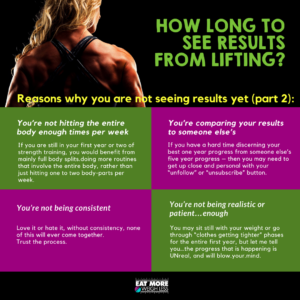 You’re not doing compound movements
You’re not doing compound movements
If you’re not seeing major body changes, it could be for lack of major body movements. If you’re hitting the gym and only concentrating on biceps, triceps, and abs, you’re putting a major ceiling on your results. Compound movements are the basis of most effective routines for a reason. They work in the actual way that your body works, strengthening your joints and tendons (in addition to your muscles), working multiple muscle groups at once, and burning more calories overall than an isolated move hitting the same muscle group would. Obviously, there’s a time and place for everything, including isolated moves, but generally the newer you are, the more compound moves should be in your routine for best results.
You’re not hitting the entire body enough times per week
As with compound moves, newbies should be doing more routines that involve the entire body, rather than just hitting one to two body-parts per week. The traditional splits that are seen in the bodybuilding community work extremely effectively…for veteran bodybuilders. If you are still in your first year or two of strength training, you would benefit from mainly full body splits. Not only do these types of workouts get the heart rate up higher, they also produce faster results. Generally speaking, the less amount of time you’ve been lifting, the more often you can work that body-part per week. A typical newbie routine could consist of up to 3 total body workouts per week, or 2 upper, 2 lower (alternating). The opposite often holds true for vet lifters who need more rest per part — hitting the body part hard, with higher volume, 1-2xs/week, max is optimal and prevent over-training.
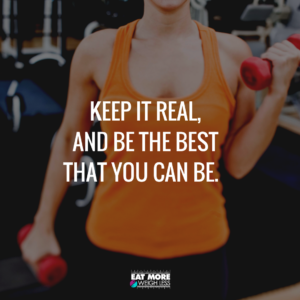 You’re comparing your results to someone else’s
You’re comparing your results to someone else’s
Try not to compare yourself to anyone else. If you feel the need to look around for an ideal body goal to shoot for, make sure that it aligns with YOUR genetics, time, interest, and drive. Most importantly, note their starting point. There’s no point in shooting to look like a pro figure competitor, when you don’t have the inclination or desire to put in the time that they do. There’s also no use comparing yourself to someone who has taken over a decade to attain their body, and bashing yourself for not accomplishing similar results in your first year of lifting. Hint: most women you see in fitness magazines, Instagram, or the internet — with any amount of muscle “tone” — have put in years of serious training and eating (and/or have been photoshopped…but I digress). Keep it real, and be the best that you can be. If you have a hard time discerning your best one year progress from someone else’s five year progress – then you may need to get up close and personal with your “unfollow” or “unsubscribe” button. Don’t keep images, magazines, or Facebook “friends” around that make you feel that you’re accomplishing nothing. Surround yourself with pictures of yourself, and compare new pictures of yourself to the ones from the beginning of this journey. (But please don’t compare pics of your 40 year old self to pics of your 15 year old self…that’s just plain freaky)
You’re not being consistent
Love it or hate it, without consistency, none of this will ever come together. If someone lifts, gets frustrated because the results aren’t coming fast enough, and then goes back to cardio madness, they will be convinced that nothing is working. Repeatedly lowering cals in a muscle building phase, or under-cutting rest periods in a strength phase, or only sticking to a workout for a couple of weeks before switching “back” is a recipe for disaster. Trust the process. As mentioned previously, most lifters with ultra defined musculature took years, upon years, upon Y.E.A.R.S. to develop. Getting frustrated because you don’t look like a person on a magazine/DVD cover, your personal trainer, or (fill-in-the-blank) WFBB Pro, after completing a 4-12 week program will not make the process go any faster. In fact, it makes take wayyyy longer. Think of your journey as a college degree, every time you “change your major” you tack on time to your journey. If you plan on seeing some impressive results, you’ve gotta buckle down, make the decision, and stick.with.it. Constantly doubting, and thinking that things aren’t working — creates the exact environment you’re expecting.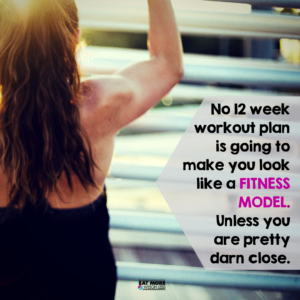
You’re not being realistic or patient…enough
It’s really hard to put your lifting progress on a timetable. Especially in the first year or so of lifting when you’re getting the most coveted results of any lifter: newbie gains. losing fat and gaining muscle at the same time. It will never again happen in your lifetime of lifting, but it can’t be measured by typical dieting methods of measurement. You may sit still with your weight or go through “clothes getting tighter” phases for the entire first year, but let me tell you…the progress that is happening is UNreal, and will blow.your.mind. It’s just sad that so many of us come from a dieting standpoint and expect things to be so perfectly linear, that we never see results of all the hard work we put in come to fruition. We get scared, run back to “old” methods, and then when those methods “appear” to be working – we assume that it’s because we went back to the old stuff (cardio/circuits/super restrictive eating/starving), not actually understanding that it’s results of lifting that were there all along. So then we keep doing the old stuff, thinking that it will only get better, only eventually undo the results, and put ourselves back at square one.
Vets: how long did/has it taken you to see results? Any tips for a newbie or frustrated lifter that’s just not seeing the results they want?

by Trish Adams | Sep 9, 2014 | Nutrition
 There are many reasons you might want to make changes to your diet. You might want to overcome a health problem, improve body composition or just increase the amount of nutrients you’re eating each day. Figuring out where to start can often be a stumbling block. Should you do a complete kitchen overhaul and wipeout the pantry? Should you swear off fast food and cook every meal?
There are many reasons you might want to make changes to your diet. You might want to overcome a health problem, improve body composition or just increase the amount of nutrients you’re eating each day. Figuring out where to start can often be a stumbling block. Should you do a complete kitchen overhaul and wipeout the pantry? Should you swear off fast food and cook every meal?
Before overwhelming yourself with too many questions, you first need to determine where you are in order to know what you need to do next. Determining your readiness for change can help you determine your path.
I like what I eat. I don’t want to change.
Sometimes we know that making changes to our diet, like eating sufficient fiber everyday, might be something that’s good for us. You might want to lose weight or change your physique in some other way, but you don’t really want to make the changes to your diet that will help you to reach your goal. If this sounds like you, you’re in the “pre-contemplation” stage, which just means that you’re not yet ready to make changes in your eating.
What you should do Jumping into changes right now is probably not the best idea. Rather, focus on getting your mind used to the idea of making a change first. Likewise, to get better prepared, consider educating yourself about food, the role nutrients play in your body or what changes might help get you closer to your goal.
 Change? I’m still thinking about it.
Change? I’m still thinking about it.
If you find yourself giving some serious thought to making diet changes, but you haven’t pulled the trigger, you’re in the “contemplation” stage. In this stage you see the value in the change, but you may not know how to go about implementing it.
What you should do Start by identifying anything that might be standing in the way of you implementing diet changes. Write down these limiting factors and, for each obstacle, list a solution. Set a goal for yourself on how you will overcome each item listed. Perhaps you want to include protein smoothies, but don’t own a blender or you want to eat more homemade meals, but don’t think you have the time. A solution might be to cook and freeze meals or set your slow cooker before work. Remember to be specific with your solutions.
I’m ready for diet change. Let’s do this!
Finding solutions to your limiting factors is a good sign that you are ready to move forward with your diet changes. In the “preparation” stage, you know what you need to do to make changes and you’re ready to put a plan in place to make it happen!
What you should do Having a detailed plan will help you stay focused when you’re preparing for diet changes. Start by identifying the dietary habits that you want to adopt. For each habit decide if it is realistic or if it needs to be broken down into a smaller habit. Remember, doing a diet overhaul is not a good place to start. Instead, focus on just one or two small, but powerful habits to implement at a time.
Write down your plan, noting what action you will take each day. If you want to increase the protein in your diet, you might start by identifying a protein to include each day at breakfast. Perhaps you’ll eat yogurt, eggs, cheese or a protein shake? Remember to be specific!
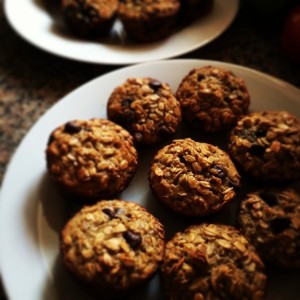 Changes that last
Changes that last
Making changes to your diet can be challenging, but it is most certainly doable. Give yourself time to adopt each new habit and always congratulate yourself for any improvement you make, no matter how small. Regardless of which stage you are starting at, there’s always a way to take it to the next level.
Rather than rushing into something that will overwhelm you, figure out where you are right now and put yourself on a path to success, moving through each phase as you’re ready. By allowing yourself the time and patience that big changes need, you’ll be healthier, more fit and ultimately with changes that last.

by EM2WL | Sep 5, 2014 | Reviews
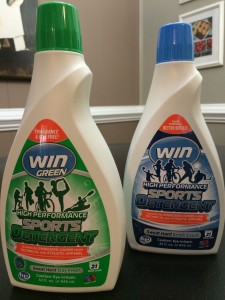 I recently came back from another extended vacation to the West Coast and — after picking up all of my accumulated mail from the time away (and crying over a few expired coupons/offers) — I was excited to see that my WIN Detergent samples had arrived while I was away!
I recently came back from another extended vacation to the West Coast and — after picking up all of my accumulated mail from the time away (and crying over a few expired coupons/offers) — I was excited to see that my WIN Detergent samples had arrived while I was away!
As a Fitfluential ambassador, EM2WL occasionally gets some goodies to review – and this one came right on time for me. Granted I didn’t get bombarded in Reebok apparel and romp through the parks of NYC like Trish, but hey EVERYone has to do laundry at some point right? And we are talking to pretty decent sized bottles here, that are made for getting sporty smells out of workout clothes.
I will say that our household certainly gave WIN a run for it’s money, lol. As a personal trainer and avid exerciser I definitely contribute my share of smellies to the laundry pile. Did I mention that I workout at home — in a converted garage — with an AC that only works if I remember to turn it on 30-60 minutes in advance? :P
But my own sweatfests aside, my guys also use the home gym in the evenings…long after I’ve turned the AC off again. And if I can barely remember to turn the AC on in advance, you can only imagine the sweatbox that they workout in. Ick. Hubs also works in construction. Technically he owns the company, but apparently that doesn’t stop him from wearing construction adhesive, sawdust, dirt, and sweat like the latest fad.
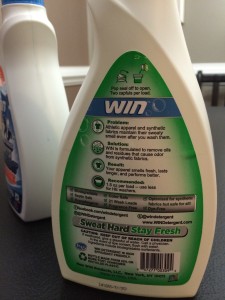 And oh yeah, there’s the kid. He’s 17. Plays basketball all.the.time, bathes/showers/get dressed “as needed” – especially in the summer. Double Ick. Did I mention he’s 17? Yeah…so laundry gets done like…the day after never. BUT, the kid pays top dollar for all of his athletic apparel, and LIVES in it. Seriously. Eats, sleeps, and even swims in basketball shorts. Apparently, mesh (or whatever those shorts are) are the new denim?
And oh yeah, there’s the kid. He’s 17. Plays basketball all.the.time, bathes/showers/get dressed “as needed” – especially in the summer. Double Ick. Did I mention he’s 17? Yeah…so laundry gets done like…the day after never. BUT, the kid pays top dollar for all of his athletic apparel, and LIVES in it. Seriously. Eats, sleeps, and even swims in basketball shorts. Apparently, mesh (or whatever those shorts are) are the new denim?
Anyway…with all that said, I was pretty interested to see how WIN would hold up to the test (especially of the basketball stuff that gets washed who-knows-when?).
My usual detergent is ALL Free & Clear, and though we have the occasional sample of GAIN (my MIL is addicted and always trying to convert us), that’s the basis of my comparison.
So first things first: smell. WIN (regular) had a great light/fresh scent, while the green version had no smell (as expected). The scented version was not so perfume-y that it would merely cover up the “funk,” and it really left a pleasant after-smell once the clothes finished washing. Considering how bad a monthly – if that – washed laundry pile in a teen boys room can smell, this is no small feat.
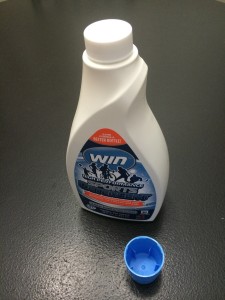 The smell of the laundry before did not disappoint (for testing purposes) and the smell after was actually rather pleasant for the scented version. The after wash smell of the scent-free version was simply a “clean” smelling pile of clothes, pretty much comparable to what we’re used to with ALL. They didn’t stink, but they weren’t a bed of roses, lol. Although his every day apparel is basketball clothes — and he does plenty of activity in them — I’m thinking that this would be an even better trial run next month when basketball season starts back.
The smell of the laundry before did not disappoint (for testing purposes) and the smell after was actually rather pleasant for the scented version. The after wash smell of the scent-free version was simply a “clean” smelling pile of clothes, pretty much comparable to what we’re used to with ALL. They didn’t stink, but they weren’t a bed of roses, lol. Although his every day apparel is basketball clothes — and he does plenty of activity in them — I’m thinking that this would be an even better trial run next month when basketball season starts back.
Of course the next question would be: did they actually come clean? Well, we weren’t dealing with any really tough stains or anything, so I can’t vouch for any special “stain fighting properties”– though I don’t know if that’s even a WIN claim. No dramatic brightening or whitening, but I was also washing mostly darker clothing (reds and blacks are the kids staples). No colors were faded, which is a huge plus because our household is big on that (I also don’t put certain items in the dryer, which helps of course). But I can say that I didn’t notice anything really go in dirty, and come out looking as if it had never been washed. It cleaned pretty comparable to what we’re used to with ALL.
Packaging. I’m assuming that the newer bottles that I was sent are an accurate representation of what would be on the market. I thought the shape/design of the bottle and labeling were pretty cool. The bottles were easy to maneuver and pour for someone with smaller hands like myself. I love that you can pretty much look at the label and understand that it’s a sports detergent. Also the allergen-free bottle being called and colored “green” makes it obvious for marketing to specific population needs. My only issue with the bottle design, was the the multi-layer cap. As with most detergent bottles, the cap is the measuring cup. Only in this case, there’s a cap under the cap — so one screw-on cap, and one that sits atop that one. The measuring cap only fits with the screw-on in place, or it would simply come right off without it. When I’m in my laundry zone, I just wanna uncap, pour, recap, and go. Not uncap, unscrew, pour, rescrew, recap, and go…
 The other issue with the cap (and this is true of other detergents as well), is that the recommended amount of detergent to use exceeds the amount that the cap will hold. With the recommended minimum being 1.5 oz (see label pic above), you need to use one and a half cups per load. Not a deal breaker, of course, but I just don’t get why manufacturers do this.
The other issue with the cap (and this is true of other detergents as well), is that the recommended amount of detergent to use exceeds the amount that the cap will hold. With the recommended minimum being 1.5 oz (see label pic above), you need to use one and a half cups per load. Not a deal breaker, of course, but I just don’t get why manufacturers do this.
All in all, I would say that in my brief trial (about 2-3 loads with each detergent), WIN is definitely a win. The ability of the detergent to high perform as promised, more than outweighs the awkward cap issues. Currently going for about $10/bottle on Amazon, you’d probably look to use WIN to supplement your usual laundry stand-by, allowing each laundry to do what it does best. I still have an econo-sized container of ALL left, so I’ll be using it up for our regular scheduled laundry. But I’ll be breaking out the rest of my WIN samples next month when my son’s basketball seasons is back in all it’s full (smelly) glory.

by EM2WL | Sep 3, 2014 | Fitness Cycles (Periodization)
When someone first begins working out, pretty much anything they do can and likely will bring results. That’s why it’s not uncommon for newbies, or those who spend most of their time training them, to have a wide variety of go-to strategies that “work.” Though most any strategy can obtain perceived results short term, in order to maintain results, you’d have to be consistently working out, even after you’ve gotten the desired results. To the untrained eye, it would seem that doing more of the exact thing that first brought the results would be the key to maintaining them. But this is where our newbie gains tend to lead us astray.
After the first year or so of doing the same workouts, your body starts to adapt, and you hit the inevitable plateau. Unless you train with some form of periodization.

Chalean Extreme is great for Endurance and Hypertrophy phases
Periodization takes plateaus into account beforehand, and plans accordingly to prevent them. This means that instead of doing the same workout plan/DVD/class day in and out, you are switching “phases” (endurance, hypertrophy, strength/power) every 4-6 weeks or so (depending on your training goals).
Endurance: as the name implies, builds endurance of the muscles. This allows you to lift heavier weight for longer periods of time. You typically know you need to work on endurance when you go to perform a heavy lift (say, a barbell row), but your smaller muscles won’t allow you to go as heavy as you know you could (forearms or grip strength give out). If you or someone you love were falling off of a building or cliff, you’d better pray that one of you has enough endurance to hold on. This is also the phase that enables you to carry all your grocery bags, by the handles, in one shot (for the less dramatic). The endurance phase is pretty much anything over 12 reps, with less than 30 seconds rest between exercises. Most workout DVDs fall into this category (more on that here).
Hypertrophy: This phase is where you add size to the muscle. This phase gives the “pump” that lets you actually see the muscles (the fave phase of bodybuilders). The hypertrophy phase can be anywhere from 7-12 reps, with 30-60 seconds rest between sets.
Strength: As it’s name implies is meant to build your strength. This is the phase that helps you to actually function in life. Being able to stand from a sitting position, push yourself out of bed, pick up your child, help a friend push their car, or pack a moving truck. This phase just may save your life (after all, in the cliffhanger above — the endurance may help you hold on, but strength will PULL the person up!) This phase may typically require a bit more food, as strength is derived from how you fuel your body. It’s incredibly hard to gain true strength while eating in a deficit once you leave the newbie gain period. (All you have to do is eat a bit more during ONE strength phase to truly understand that statement.) The Strength phase is typically anything in the 1-7 rep range.
As you can see, all phases (even the ones you despise) are beneficial, and serve a purpose at the time. Funny that even the two at opposite ends of the spectrum, “complete” one another. This is why many of the 90-day systems like P90X, Chalean Extreme, and STS are so popular. They typically include some form of built in periodization that, when repeated consistently, tend to give better results than what a person may come up with on their own. (Side note: Cathe’s STS program is the only one of the above mentioned that include all three of the above phases, which is why its so highly praised by EM2WL.)

Rather than simply treating each workout as a punishment for your body not looking a certain way, try periodization to prevent plateaus. Having a periodized focus gives you purpose in your workouts, multiple short-term (ie “monthly”) fitness goals to strive for, and a bonus: a confidence boost from actually achieving them!
What you’ll typically find is that because of your new attitude and willingness to workout with purpose, you’ll continue to see more benefits and improvements (mentally and physically). The mental aspect of getting stronger and doing things you couldn’t physically do before is addicting. And when you’re focused on those things – even more physique improvements tend to happen as a byproduct. Which makes it even more addicting. Fitness goals for the win!
Do you plan your workouts in phases? Or do you prefer to go with the flow/stick with your fave workouts?

 Let’s use this scenario as an example. You head to the gym on a Monday and have an awesome lift. You’re feeling good about yourself because you added 10 pounds to your bench and 20 pounds to your deadlift. In short, you feel like a BEAST!!! You wake up the next day, rush to the mirror and promptly start looking for changes, expecting to be rewarded for all your hard work (or…at very least, another glance at those gorgeous muscles you saw poppin yesterday). Instead you feel fluffy — not at all what you expected — and you’re holding water (100% normal following an incredible lift session!). Suddenly your attitude towards the day goes from “I’m ready for you!” to “Why should I even stay on track or hit the gym today?” Negative thoughts start to creep in and you’re convinced you have failed.
Let’s use this scenario as an example. You head to the gym on a Monday and have an awesome lift. You’re feeling good about yourself because you added 10 pounds to your bench and 20 pounds to your deadlift. In short, you feel like a BEAST!!! You wake up the next day, rush to the mirror and promptly start looking for changes, expecting to be rewarded for all your hard work (or…at very least, another glance at those gorgeous muscles you saw poppin yesterday). Instead you feel fluffy — not at all what you expected — and you’re holding water (100% normal following an incredible lift session!). Suddenly your attitude towards the day goes from “I’m ready for you!” to “Why should I even stay on track or hit the gym today?” Negative thoughts start to creep in and you’re convinced you have failed. t most definitely is time for a change! Consider adding phases to your routine to be sure that you are getting the most out of your efforts. At a minimum, try a new exercise class, take your workout outside or invite a friend to the gym. Change it up. You will be amazed by your body’s ability to adapt to something new.
t most definitely is time for a change! Consider adding phases to your routine to be sure that you are getting the most out of your efforts. At a minimum, try a new exercise class, take your workout outside or invite a friend to the gym. Change it up. You will be amazed by your body’s ability to adapt to something new.


 Ummm…Says who??? ;) How do we determine how many sizes we should be up or down within a year? I pray not by the same industry standards that tell us to “eat-less-than-you-need-to-support-your-body-in-a-comatose-state” for weight loss?
Ummm…Says who??? ;) How do we determine how many sizes we should be up or down within a year? I pray not by the same industry standards that tell us to “eat-less-than-you-need-to-support-your-body-in-a-comatose-state” for weight loss? Confession time: The other day, I went out in frustration over all my older, lower rise jeans that weren’t fitting. Taking my own redundant advice — I bit the bullet and bought the exact same jeans in LARGER sizes to make sure they fit over my butt. Listen…the size was WAY larger…would you know I had FIVE people tell me I need to STOP losing weight when I was wearing those jeans?! I have gained over 10 lbs (apparently all in the bootay)!! But wearing jeans that FIT ME (note…did not say jeans that “I fit” into to) FIT, baby. Get clothes that fit, forget the rest. By the time you can squeeze into jeans from over a year ago, they’re probably outdated anyway :P
Confession time: The other day, I went out in frustration over all my older, lower rise jeans that weren’t fitting. Taking my own redundant advice — I bit the bullet and bought the exact same jeans in LARGER sizes to make sure they fit over my butt. Listen…the size was WAY larger…would you know I had FIVE people tell me I need to STOP losing weight when I was wearing those jeans?! I have gained over 10 lbs (apparently all in the bootay)!! But wearing jeans that FIT ME (note…did not say jeans that “I fit” into to) FIT, baby. Get clothes that fit, forget the rest. By the time you can squeeze into jeans from over a year ago, they’re probably outdated anyway :P You’re not doing compound movements
You’re not doing compound movements You’re comparing your results to someone else’s
You’re comparing your results to someone else’s





 I recently came back from another extended vacation to the West Coast and — after picking up all of my accumulated mail from the time away (and crying over a few expired coupons/offers) — I was excited to see that my
I recently came back from another extended vacation to the West Coast and — after picking up all of my accumulated mail from the time away (and crying over a few expired coupons/offers) — I was excited to see that my  And oh yeah, there’s the kid. He’s 17. Plays basketball all.the.time, bathes/showers/get dressed “as needed” – especially in the summer. Double Ick. Did I mention he’s 17? Yeah…so laundry gets done like…the day after never. BUT, the kid pays top dollar for all of his athletic apparel, and LIVES in it. Seriously. Eats, sleeps, and even swims in basketball shorts. Apparently, mesh (or whatever those shorts are) are the new denim?
And oh yeah, there’s the kid. He’s 17. Plays basketball all.the.time, bathes/showers/get dressed “as needed” – especially in the summer. Double Ick. Did I mention he’s 17? Yeah…so laundry gets done like…the day after never. BUT, the kid pays top dollar for all of his athletic apparel, and LIVES in it. Seriously. Eats, sleeps, and even swims in basketball shorts. Apparently, mesh (or whatever those shorts are) are the new denim? The smell of the laundry before did not disappoint (for testing purposes) and the smell after was actually rather pleasant for the scented version. The after wash smell of the scent-free version was simply a “clean” smelling pile of clothes, pretty much comparable to what we’re used to with ALL. They didn’t stink, but they weren’t a bed of roses, lol. Although his every day apparel is basketball clothes — and he does plenty of activity in them — I’m thinking that this would be an even better trial run next month when basketball season starts back.
The smell of the laundry before did not disappoint (for testing purposes) and the smell after was actually rather pleasant for the scented version. The after wash smell of the scent-free version was simply a “clean” smelling pile of clothes, pretty much comparable to what we’re used to with ALL. They didn’t stink, but they weren’t a bed of roses, lol. Although his every day apparel is basketball clothes — and he does plenty of activity in them — I’m thinking that this would be an even better trial run next month when basketball season starts back.



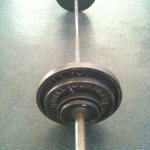
Recent Comments